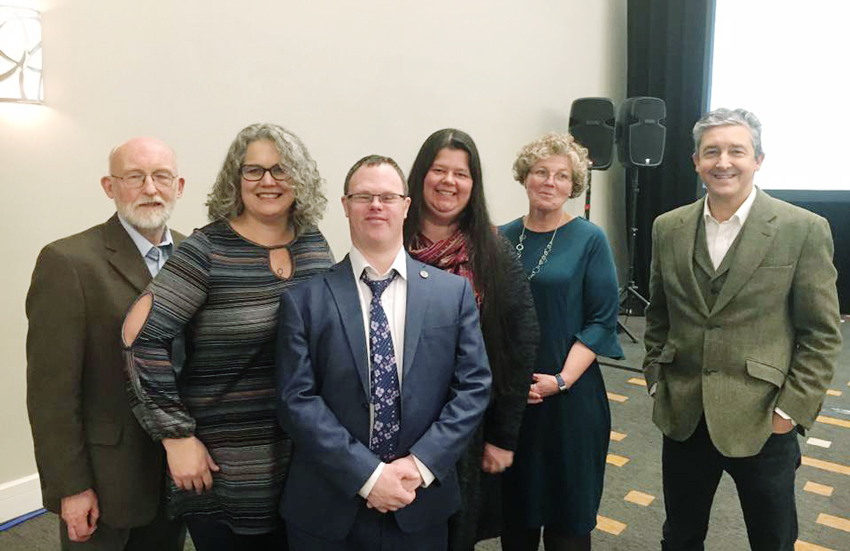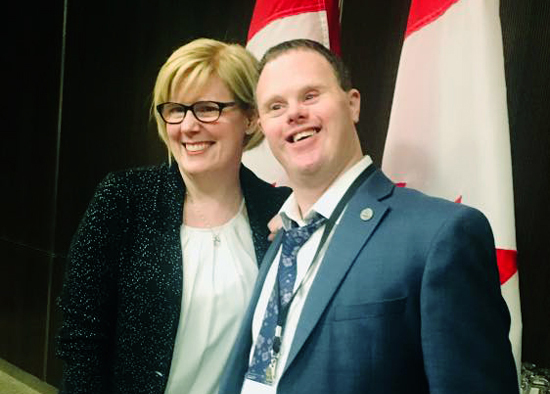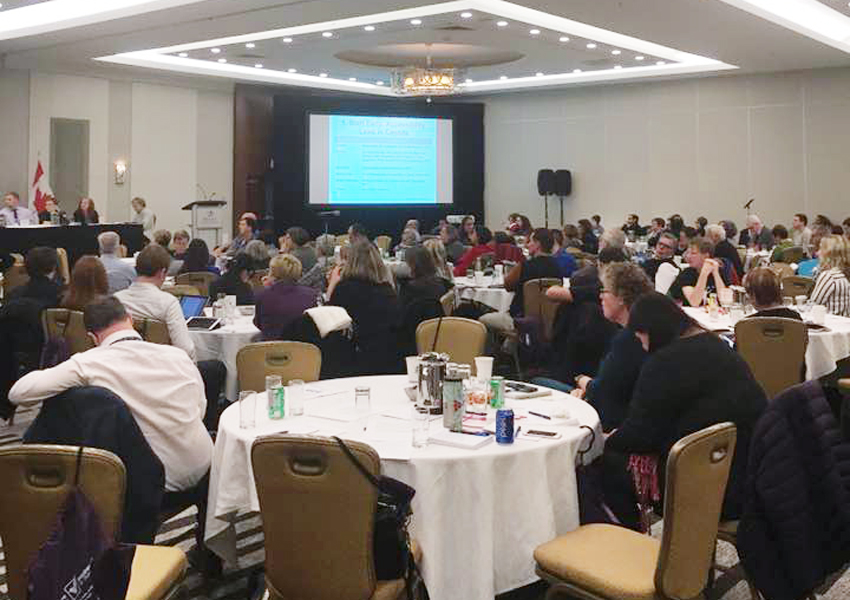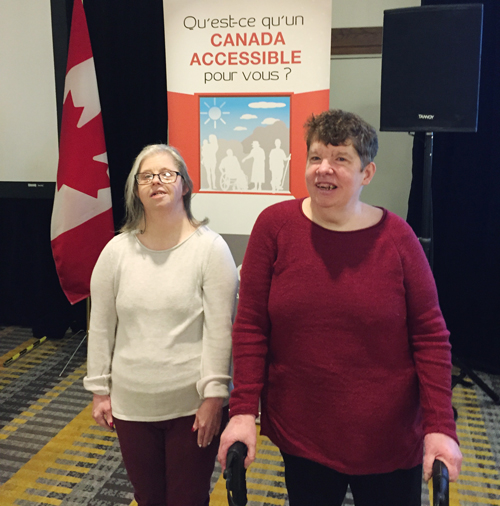Blog
Measuring Impact in the Movement for Inclusion
By Ian Pellerin, Jenn Power and John Rietschlin
L’Arche Canada participated in the 9th annual Federal Policy Forum on Inclusion in Ottawa on December 3, 2018. It was hosted by the Canadian Association for Community Living (CACL) and People First of Canada (PFC), in collaboration with the Office for Disability Issues, Employment and Social Development Canada. This year’s theme was Inclusion: What Gets Measured Gets Done.

Above: L’Arche delegates John Rietschlin, Jenn Power, Ian Pellerin, Tricia Scott, Lori Vaanholt, and Louis Pilotte at the Policy Forum
Listening first to Ian’s experience
Ian Pellerin came to Ottawa “to talk to people about my life and ask them some questions.” But there wasn’t a lot of time for that during the policy forum. He found the sessions “too long, and kind of boring.” When asked what they were about, he said that they were “hard to understand.” (The same could be said about this article…) Clearly, there’s work to be done to make the Inclusion movement and policy development more accessible and inclusive.
Ian was grateful for the times during his trip to Ottawa when he was able “to shake hands, to introduce myself, to tell them where I’m from. And I asked their names and where they were from, too.” When not wearing his suit, Ian wore his L’Arche hoodie proudly. He pointed to the logo and asked people, “Have you heard of L’Arche?” Taxi drivers, flight attendants, politicians, all learned about welcome and friendship from Ian.
Ian says his hope for Canadians with disabilities is “to have good friends, a good job, maybe a girlfriend or a boyfriend. And time to relax and sleep in on the weekends!” They sound like pretty good dreams, ones that federal policymakers need to hear.

Left: Ian Pellerin with Minister Qualtrough
The Importance of this Policy Forum
There are few places that bring together people with intellectual disabilities, their families, supporters, and other advocates with federal policymakers and researchers. The Federal Policy Forum is one of these. Being in the room created opportunities to talk to the people who are influencing decisions around how the federal government will spend millions of dollars to support inclusion. L'Arche has something to say here and we have lots to learn, but this will only happen if we are present.
The Honourable Carla Qualtrough, Minister of Public Services and Procurement and Accessibility attended this year. She has been a champion in advancing the rights of persons with disabilities and in the creation of Canada’s first federal accessibility legislation. In her opening remarks, Minister Qualtrough advanced the self-advocates’ refrain, “Rather than nothing about us without us, how about nothing without us, because everything is about us!”

The day featured four panels on national priorities. Each panel included a self-advocate (a person with a disability) and a family member along with government representatives and disability advocates. The self-advocates and family members talked about the importance of being known and participating in their local community. They told stories of when they were left out, and stories of when they were included and what a difference this made in their lives. Read also the article on CACL’s site.
In L’Arche, we know how to create community, to nurture people’s gifts, and help them share those gifts with the world. How can we articulate what we know and share it with others? And we have so much to learn. As we open our doors to share our experience, how can we invite others to share what they know: about inclusive design, government policy and the Convention on the Rights of Persons with Disabilities, and the current research? This is what it means, after all, to be a learning culture.
The importance of measuring impact
Measuring impact is a major trend of government policy and philanthropy. In L’Arche, we’ve tended to stay far away from anything that feels like reducing people to numbers. We are not alone in this – as several presenters at the Forum made clear. Here again, we have something to contribute if we talk to experts who are developing multi-dimensional approaches to measurement. It’s clear that stories that complement the numbers are a powerful way to demonstrate impact. We love to tell stories in L’Arche, yet we need to find ways to share them with researchers.
Many questions remain. How are we defining this “inclusion” that we propose to measure? It is numbers of jobs created for person with disabilities, or kids in “regular” classrooms, ramps built, or university admissions? These can be dangerous measurements full of value judgements, reducing people to value for money. What about collecting stories of people whose lives have value and who feel welcomed as part of their community? Folks who are contributors to their church community or their family? How do we capture – and value – this data? And who is doing the measuring? People with intellectual disabilities likely won’t be, and that’s another gap for sure.
Challenges and Opportunities
L'Arche needs to develop confidence and competence in speaking to governments and to other organizations about the policies that support inclusion. We recognize that outreach is an important part of our mission, but we tend to equate it with presentations to church groups and in school classrooms. Outreach needs to include reaching out to elected officials, other organizations, and the disability policy community – both to speak and to listen.

Left: Accessibility legislation session in Toronto
How can we talk about complex matters – like legislative policy – in a way that provides opportunities for meaningful inclusion and input from a diversity of people with and without disabilities? The disability community can fall into the same trap as mainstream society – designing processes that are not accessible for many people with intellectual disabilities. Inclusive design means planning the process from the beginning to include people marginalized because they don’t use verbal communications or have intensive medical or other support needs. Representation matters.
And are we able to look beyond the boundaries of our own organizations and communities to see the common mission we share? How can we work together in a way that increases our impact and amplifies the voices of persons with intellectual disabilities in Canada?
If we look over the past fifty years, Canadians with disabilities and Canadian society have come a long way. But there are always new challenges as society, technology, and institutions continue to change. Learning to use policy and regulations from the Convention on the Rights of Persons with Disabilities (CRPD) or the new federal accessibility legislation is one way that we can contribute to advancing inclusion. Changing the world one heart at a time certainly, but also at the level of the systems and structures that shape our lives.
Make a Donation Now
Themes
- Accessibility
- Advocacy
- Aging
- Amitié
- Apprentissage
- Artist
- Belonging
- Care
- Caring for Others
- Celebration
- Collaboration
- Communication
- Community
- Contributions
- Core Members
- Creativity
- Daily Life
- Day Center
- Day Program
- Disability Arts
- Diversity
- Gifts and Abilities
- Gratitude
- History
- Inclusion
- Institutions
- Intentional Community
- Leadership
- Legislation
- Life-sharing
- Listening
- Mission
- More Human Society
- Mutual Relationships
- Neighbourhood
- Outreach
- Partnership
- Personal Journey
- Persons with Disabilities
- Policy
- Project
- Respect
- Responsibility
- Rights
- Service to Others
- Society
- Solidarity
- Story
- Teamwork
- Togetherness
- Traditions
- Values
- Vision
- Well-Being
- Workshop
- World
